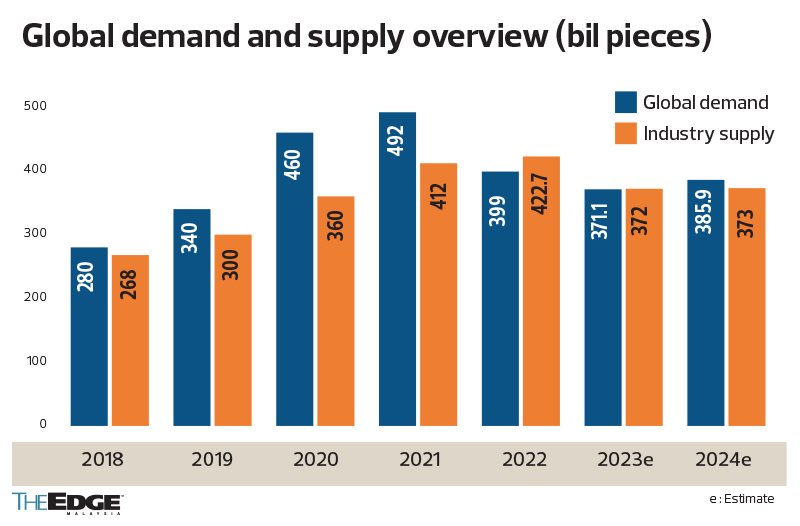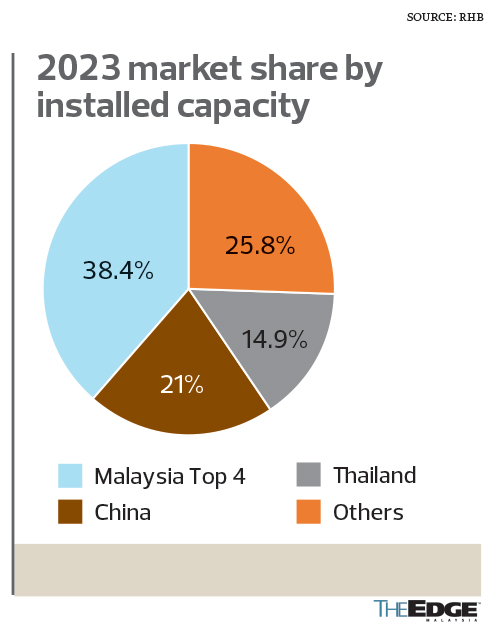
This article first appeared in Capital, The Edge Malaysia Weekly on October 9, 2023 - October 15, 2023
BATTERED by falling demand, oversupply and stiff competition from China and Thailand, the local glove industry is slowly recovering, but a more substantial improvement can only be expected in the second half of 2024 at the soonest, according to analysts.
Although a weak ringgit — which declined to a low of 4.7302 against the greenback last week — bodes well for exporters, including glove manufacturers, there are other variables that impact their profitability, says a healthcare analyst with a non-bank-backed research house.
Quarter on quarter, he believes glove makers will be able to post improved financial results for the July-September quarter, helped by favourable foreign exchange and lower raw material prices.
Kossan Rubber Industries Bhd, in particular, is expected to be the first to return to profit on a quarterly basis. Compared to its peers, Kossan incurred a much lower net loss of RM3.3 million for the April-June period. Supermax Corp Bhd’s net loss was at RM7.2 million, while Top Glove Corp Bhd and Hartalega Holdings Bhd posted much larger net losses of RM130.6 million and RM52.5 million respectively.
Given the stabilisation in the average selling price (ASP), the analyst is confident that prices are on the mend and that the situation will not worsen.
Inter-Pacific Securities analyst Wong Choo Hong is also of the view that prices have bottomed out following the implementation of many measures, including a reduction in production lines, but cautions that buyers are still shopping around for the most competitive prices.
“I don’t see a drastic improvement this year and next year, partly because ASP is still very much dampened. Overall, it’s still not out of the woods yet.
“Customers are expecting prices to go down. They are now going to China and Thailand for that purpose. Chinese and Thai glove makers offer lower glove prices than us partly because of the lower energy prices there,” he tells The Edge.
While local glove makers can cut prices to regain market share, Wong says the move will lead to a lack of economies of scale because they built many factories and production lines during the Covid-19 pandemic. “They’re still trying to improve things, but I believe that improvement will not come in so soon in terms of cost structure.”
Although less optimistic of the sector at present, Wong expects a significant improvement beyond 2024. He explains: “There’s still a lot of oversupply of gloves in the market. What they want to do now is just to clear the stocks, so that they will be able to go back to pre-pandemic levels in terms of the supply-demand equilibrium.”
Nonetheless, he says the glove industry will be supported by rising hygiene awareness, with expected higher purchases from hospitals and even general households. “Demand will increase slowly on general awareness of health.”
Kenanga Research in a Sept 26 note says that the worst is over for the glove sector in terms of earnings downgrades, although it may not be out of the woods yet. This is underpinned by easing cost pressures and savings emanating from the decommissioning of older plants moving into the second half of the year.
“In the meantime, any further decommissioning of older production facilities by local players could take more supply pressures off the sector. Industry capacity cutbacks should bring back more rational competition and hopefully stop the bleeding of the players,” it explains.
The research house notes that customers are still reluctant to commit to sizeable orders and hold substantial stocks as they expect prices to decline. Thus, the challenging and competitive business landscape will persist for the rest of the year, as a result of the massive capacity that has resulted in a suppressed industry utilisation rate.
On a brighter note, Kenanga Research says glove players can heave a slight sigh of relief over the lower cost of energy, latex and nitrile butadiene rubber, at least temporarily.
RHB Research is of the view that the stabilised ASP trend should bode well for glove makers in the near term, as an aggressive price hike could compromise volumes sold, given that customers remain price sensitive.
Industry-blended ASPs have stabilised at US$20-US$21 (RM94.60 to RM99.30) per 1,000 pieces at present, largely unchanged from 1Q2023 numbers.
As demand continues to be choppy in the near term, the research house expects meaningful recovery to happen only by the second half of 2024, as the inventory destocking pace comes in slower than expected.
“We now trim our 2023 global glove demand assumption to -7% from -5% y-o-y with a demand target of 371 billion. This should be followed by 4% growth in 2024, in our view,” it says in a Sept 20 note.
Supply-wise, RHB forecasts an annual supply of 372 billion, following the capacity rationing exercise. The research outfit expects Malaysia’s global market share by production capacity to decline to 38.4% in 2023 from 47% in 2022, owing to market share gains by China.
Since the easing of the Covid-19 pandemic, glove players have been undertaking rationalisation exercises in the face of the challenging operating landscape. Hartalega, for example, has decommissioned its Bestari Jaya facility with the objective of consolidating its operations at the Next Generation Integrated Glove Manufacturing Complex (NGC) in Sepang. The decommissioning exercise comprising four production plants is targeted to be completed by 1Q2024.
Earlier, Kossan decommissioned two older plants with a total capacity of three billion pieces to lower its operating costs.
With the industry utilisation rate still hovering at a sub-optimal level of less than 50%, RHB believes the decommissioning exercises could help alleviate margin pressure and eventually lead to better operating efficiencies, given that the obsolete domestic plants are less energy and manpower efficient.
Having gained 24.7% and 23.6% in share price year to date, Hartalega and Kossan have been the outperformers in the sector. Top Glove, however, is down 14.8% over the same period and Supermax, 4.6%.
Hartalega’s superior share price gain means it has overtaken Top Glove as the largest glove counter on Bursa Malaysia by market capitalisation.
Despite the unexciting outlook, some glove stocks have drawn interest from institutional funds. Abrdn plc (formerly known as Aberdeen Asset Management plc), for one, raised its stake in Kossan to 5.87% as at Oct 2. It emerged as a substantial shareholder of Kossan with a 5.07% stake last March.
Bloomberg data shows that most glove makers are forecast to make a profit in the current financial year. Top Glove’s net profit is estimated at RM65.4 million for the financial year ending Aug 31, 2024.
Hartalega’s is projected at RM47.6 million for the financial year ending March 31, 2024, and Supermax’s at RM20.4 million for the financial year ending June 30, 2024.
Despite its hefty share price gain, Kossan is forecast to post a net loss of RM24.7 million for the financial year ending Dec 31, 2023, before turning around with an expected net profit of RM84.6 million in the next financial year.
Based on a consensus target price of 90 sen compiled by Bloomberg, only Supermax has an upside potential of 8.4% based on last Wednesday’s closing price of 83 sen.
Save by subscribing to us for your print and/or digital copy.
P/S: The Edge is also available on Apple's App Store and Android's Google Play.




